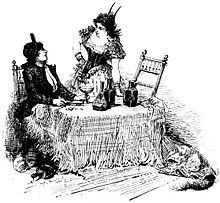 "La Groac'h de l'île du Lok" after Théophile Busnel, for Contes et légendes de Basse-Bretagne (1891) | |
| Grouping | Legendary creature |
|---|---|
| Sub grouping | Fairy |
| Similar entities | Witch, ogre |
| Folklore | Folklore |
| Country | Brittany |
| Habitat | Under or by the sea or springs |
A groac'h (Breton for "fairy", "witch" or "crone", pl. groagez) is a kind of Breton water-fairy. Seen in various forms, often by night, many are old, similar to ogres and witches, sometimes with walrus teeth. Supposed to live in caverns, under the beach and under the sea, the groac'h has power over the forces of nature and can change its shape. It is mainly known as a malevolent figure, largely because of Émile Souvestre's story La Groac'h de l'île du Lok, in which the fairy seduces men, changes them into fish and serves them as meals to her guests, on one of the Glénan Islands. Other tales present them as old solitary fairies who can overwhelm with gifts the humans who visit them.
Several place-names of Lower Brittany are connected with the groac'h, especially the names of some megaliths in Côtes-d'Armor, as well as the island of Groix in Morbihan and the lighthouse of La Vieille. The origin of those fairies that belong to the archetype of "the crone" is to be found in the ancient female divinities demonized by Christianity. The influence of Breton writers in the 19th century brought them closer to the classical fairy figure. The groac'h has several times appeared in recent literary works, such as Nicolas Bréhal's La Pâleur et le Sang (1983).